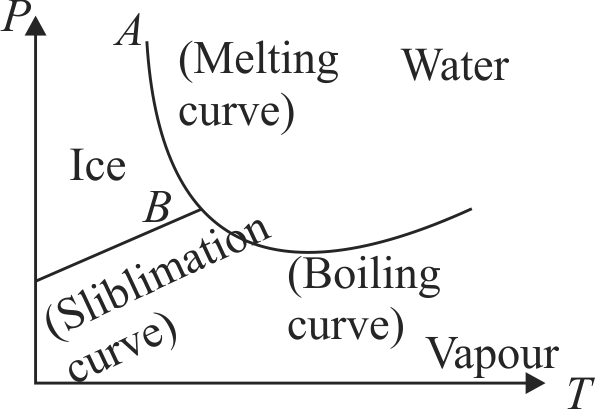366828 A solid whose volume does not change with temperature floats in a liquid. For two different temperatures \(t_{1}\) and \(t_{2}\) of the liquid, dfractions \(f_{1}\) and \(f_{2}\) of the volume of the solid remain submerged in the liquid. The coefficient of volume expansion of the liquid is equal to
366830 The coefficient of cubical expansion of mercury is \(0.00018/^\circ C\) and that of brass \(0.00006/^\circ C\). If a barometer having a brass scale were to read \(74.5\;cm\) at \(30^\circ C\), find the true barometric height at\(0^\circ C\). The scale is supposed to be correct at \(15^\circ C\).
366831
As shown in the picture a cylinder with volumetric thermal expansion coefficient of \({\gamma _s} = 3 \times {10^{ - 6}}/^\circ C\) is completely submerged and floating in a fluid at the temperature \(50^\circ C\). The fluid has volumetric thermal expansion coefficient of \({\gamma _l} = 8 \times {10^{ - 5}}/^\circ C\).
If we cool down the cylinder and fluid to \(0^\circ C\) what percentage of the cylinder's height will be out of the fluid?
366828 A solid whose volume does not change with temperature floats in a liquid. For two different temperatures \(t_{1}\) and \(t_{2}\) of the liquid, dfractions \(f_{1}\) and \(f_{2}\) of the volume of the solid remain submerged in the liquid. The coefficient of volume expansion of the liquid is equal to
366830 The coefficient of cubical expansion of mercury is \(0.00018/^\circ C\) and that of brass \(0.00006/^\circ C\). If a barometer having a brass scale were to read \(74.5\;cm\) at \(30^\circ C\), find the true barometric height at\(0^\circ C\). The scale is supposed to be correct at \(15^\circ C\).
366831
As shown in the picture a cylinder with volumetric thermal expansion coefficient of \({\gamma _s} = 3 \times {10^{ - 6}}/^\circ C\) is completely submerged and floating in a fluid at the temperature \(50^\circ C\). The fluid has volumetric thermal expansion coefficient of \({\gamma _l} = 8 \times {10^{ - 5}}/^\circ C\).
If we cool down the cylinder and fluid to \(0^\circ C\) what percentage of the cylinder's height will be out of the fluid?
366828 A solid whose volume does not change with temperature floats in a liquid. For two different temperatures \(t_{1}\) and \(t_{2}\) of the liquid, dfractions \(f_{1}\) and \(f_{2}\) of the volume of the solid remain submerged in the liquid. The coefficient of volume expansion of the liquid is equal to
366830 The coefficient of cubical expansion of mercury is \(0.00018/^\circ C\) and that of brass \(0.00006/^\circ C\). If a barometer having a brass scale were to read \(74.5\;cm\) at \(30^\circ C\), find the true barometric height at\(0^\circ C\). The scale is supposed to be correct at \(15^\circ C\).
366831
As shown in the picture a cylinder with volumetric thermal expansion coefficient of \({\gamma _s} = 3 \times {10^{ - 6}}/^\circ C\) is completely submerged and floating in a fluid at the temperature \(50^\circ C\). The fluid has volumetric thermal expansion coefficient of \({\gamma _l} = 8 \times {10^{ - 5}}/^\circ C\).
If we cool down the cylinder and fluid to \(0^\circ C\) what percentage of the cylinder's height will be out of the fluid?
366828 A solid whose volume does not change with temperature floats in a liquid. For two different temperatures \(t_{1}\) and \(t_{2}\) of the liquid, dfractions \(f_{1}\) and \(f_{2}\) of the volume of the solid remain submerged in the liquid. The coefficient of volume expansion of the liquid is equal to
366830 The coefficient of cubical expansion of mercury is \(0.00018/^\circ C\) and that of brass \(0.00006/^\circ C\). If a barometer having a brass scale were to read \(74.5\;cm\) at \(30^\circ C\), find the true barometric height at\(0^\circ C\). The scale is supposed to be correct at \(15^\circ C\).
366831
As shown in the picture a cylinder with volumetric thermal expansion coefficient of \({\gamma _s} = 3 \times {10^{ - 6}}/^\circ C\) is completely submerged and floating in a fluid at the temperature \(50^\circ C\). The fluid has volumetric thermal expansion coefficient of \({\gamma _l} = 8 \times {10^{ - 5}}/^\circ C\).
If we cool down the cylinder and fluid to \(0^\circ C\) what percentage of the cylinder's height will be out of the fluid?
